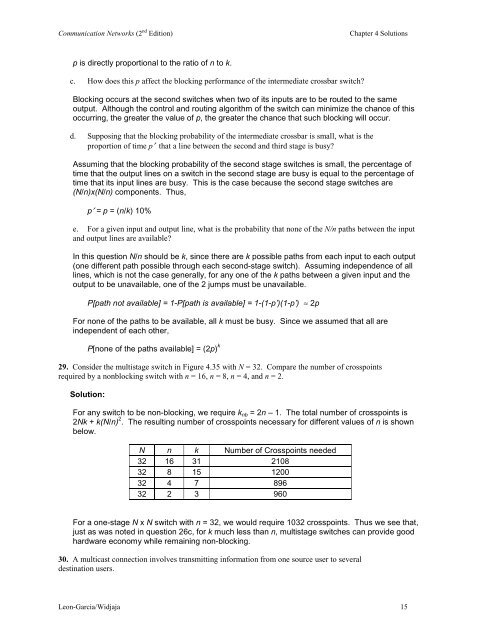Solutions to Chapter 4 - Communication Networks
Solutions to Chapter 4 - Communication Networks
Solutions to Chapter 4 - Communication Networks
You also want an ePaper? Increase the reach of your titles
YUMPU automatically turns print PDFs into web optimized ePapers that Google loves.
<strong>Communication</strong> <strong>Networks</strong> (2 nd Edition)<br />
<strong>Chapter</strong> 4 <strong>Solutions</strong><br />
p is directly proportional <strong>to</strong> the ratio of n <strong>to</strong> k.<br />
c. How does this p affect the blocking performance of the intermediate crossbar switch<br />
Blocking occurs at the second switches when two of its inputs are <strong>to</strong> be routed <strong>to</strong> the same<br />
output. Although the control and routing algorithm of the switch can minimize the chance of this<br />
occurring, the greater the value of p, the greater the chance that such blocking will occur.<br />
d. Supposing that the blocking probability of the intermediate crossbar is small, what is the<br />
proportion of time p′ that a line between the second and third stage is busy<br />
Assuming that the blocking probability of the second stage switches is small, the percentage of<br />
time that the output lines on a switch in the second stage are busy is equal <strong>to</strong> the percentage of<br />
time that its input lines are busy. This is the case because the second stage switches are<br />
(N/n)x(N/n) components. Thus,<br />
p′ = p = (n/k) 10%<br />
e. For a given input and output line, what is the probability that none of the N/n paths between the input<br />
and output lines are available<br />
In this question N/n should be k, since there are k possible paths from each input <strong>to</strong> each output<br />
(one different path possible through each second-stage switch). Assuming independence of all<br />
lines, which is not the case generally, for any one of the k paths between a given input and the<br />
output <strong>to</strong> be unavailable, one of the 2 jumps must be unavailable.<br />
P[path not available] = 1-P[path is available] = 1-(1-p’)(1-p’) ≈ 2p<br />
For none of the paths <strong>to</strong> be available, all k must be busy. Since we assumed that all are<br />
independent of each other,<br />
P[none of the paths available] = (2p) k<br />
29. Consider the multistage switch in Figure 4.35 with N = 32. Compare the number of crosspoints<br />
required by a nonblocking switch with n = 16, n = 8, n = 4, and n = 2.<br />
Solution:<br />
For any switch <strong>to</strong> be non-blocking, we require k nb = 2n – 1. The <strong>to</strong>tal number of crosspoints is<br />
2Nk + k(N/n) 2 . The resulting number of crosspoints necessary for different values of n is shown<br />
below.<br />
N n k Number of Crosspoints needed<br />
32 16 31 2108<br />
32 8 15 1200<br />
32 4 7 896<br />
32 2 3 960<br />
For a one-stage N x N switch with n = 32, we would require 1032 crosspoints. Thus we see that,<br />
just as was noted in question 26c, for k much less than n, multistage switches can provide good<br />
hardware economy while remaining non-blocking.<br />
30. A multicast connection involves transmitting information from one source user <strong>to</strong> several<br />
destination users.<br />
Leon-Garcia/Widjaja 15







